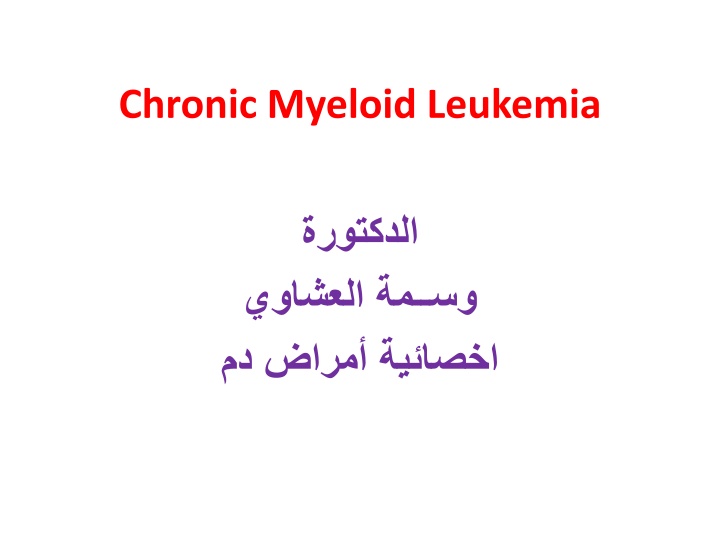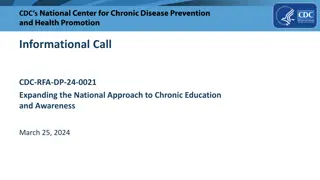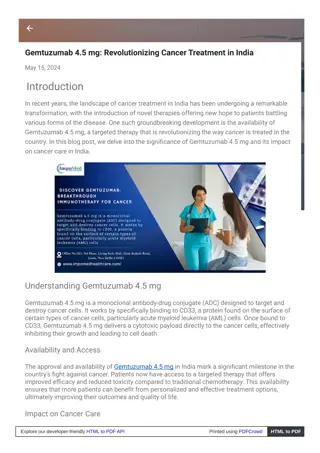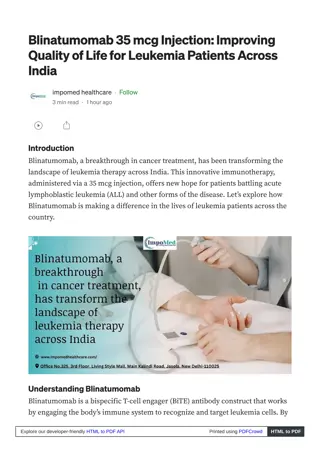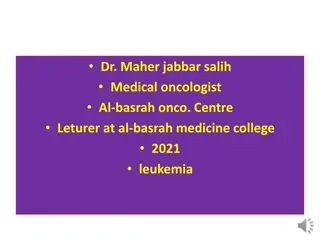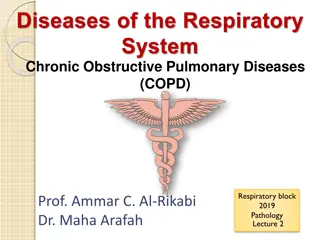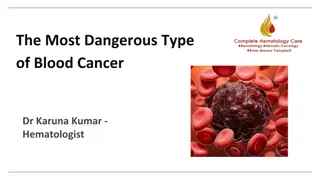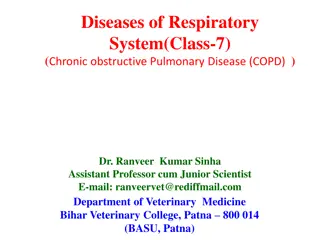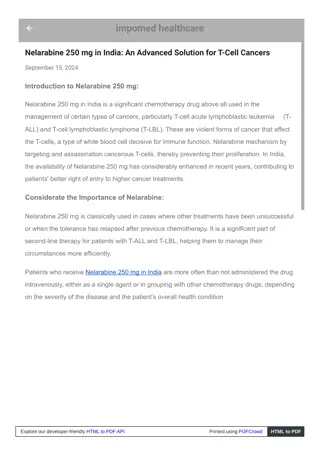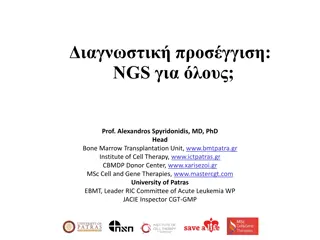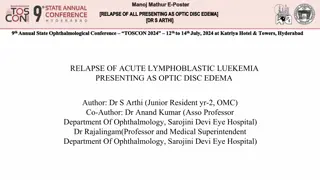Chronic Myeloid Leukemia
Chronic myeloid leukemia (CML) is a myeloproliferative neoplasm that displaces normal hematopoiesis, leading to an expanded myeloid mass. It is characterized by the BCR-ABL1 fusion gene and can be treated with tyrosine kinase inhibitors (TKIs) such as imatinib mesylate. CML typically presents in a chronic phase and can progress to a more aggressive phase if left untreated. The incidence of CML is rare and slightly higher in males, with a median onset age of 50-60 years. Despite being generally sporadic, exposure to high doses of irradiation can increase the risk of developing CML.
Download Presentation

Please find below an Image/Link to download the presentation.
The content on the website is provided AS IS for your information and personal use only. It may not be sold, licensed, or shared on other websites without obtaining consent from the author.If you encounter any issues during the download, it is possible that the publisher has removed the file from their server.
You are allowed to download the files provided on this website for personal or commercial use, subject to the condition that they are used lawfully. All files are the property of their respective owners.
The content on the website is provided AS IS for your information and personal use only. It may not be sold, licensed, or shared on other websites without obtaining consent from the author.
E N D
Presentation Transcript
Chronic myeloid leukemia myeloproliferative neoplasm classify tumors of the haemopoietic and lymphoid systems chronic myeloid leukemia (CML) is the most common subtype
Chronic myeloid leukemia Chronic myeloid leukemia clonal disease that results from an acquired genetic change in a pluripotential haemopoietic stem cell displaces normal haemopoiesis leads to a greatly expanded total myeloid mass Landmark discovery of the Philadelphia (Ph.) chromosome in 1960 t(9;22)(q34;q11) translocation in 1973 Identification in the 1980s of the BCR LAB
Chronic myeloid leukemia Until the 1980s, CML was generally incurable treated palliatively with radiotherapy and later with alkylating agents. SCT 1998 tyrosine kinase inhibitor (TKI) imatinib mesylate complete cytogenetic response and may expect substantial prolongation of survival second - generation TKIs, dasatinib, nilotinib and bosutinib, may be more effective than imatinib.
Chronic myeloid leukemia Epidemiology, a etiology and natural history The incidence of CML worldwide. It occurs in about 1.0 1.5 per 100 000 of the population CML is rare below the age of 20 years. the median age of onset is 50 60 years. The incidence is slightly higher in males than in females. The risk of developing CML is slightly but significantly increased by exposure to high doses of irradiation.(atomic bomb irradiation of ankylosing spondylitis and malignant diseases) in general, almost all cases must be regarded as sporadic without identifi able predisposing factors no familial predisposition, no definite association with HLA genotypes, No contributory infectious agent
Chronic myeloid leukemia Clinically, CML is classically a biphasic or triphasic disease that is usually diagnosed in the initial chronic , indolent or stable phase. before the diagnosis is established .. It could be 5 10 years before the disease becomes clinically manifest since the introduction of TKIs and today the majority of patients may never progress beyond the chronic phase. chronic phase used to last about 2 7 years for most patients who respond well to TKIs, survival is likely to exceed 20 years 50% of the patients who fail TKI treatment the chronic phase transforms unpredictably more aggressive phase to as blastic crisis & transformation Survival 3 9 months.
Chronic myeloid leukemia Classification Homogeneous disease characterized at diagnosis by: splenomegaly, leukocytosis and the presence of the BCR ABL1 fusion gene in all leukemic cells. A minority of patients have less typical disease that may be classified as atypical CML, chronic myelomonocytic leukemia or chronic neutrophilic leukemia (CNL). Children may have a disease referred to as juvenile chronic myelomonocytic leukemia.
Chronic myeloid leukemia Staging Sokal and colleagues in 1984 , is based on a formula that takes account of the patient s age, blast cell percentage, spleen size and platelet count at diagnosis patients who have a low leucocyte doubling time probably survive longer than those with more rapid doubling times. a complete cytogenetic response to interferon Alfa or rapid reduction in BCR ABL1 transcript numbers in patients starting treatment with imatinib are both good prognostic factors
Chronic myeloid leukemia Cytogenetics The Philadelphia chromosome(22q ) acquired cytogenetic abnormality as t(9;22)(q34;q11) present in all myeloid cell lineages some B cells a very small proportion of T cells It is found in no other cells of the body
Chronic myeloid leukemia Clinical features splenomegaly, hemorrhage or anemia almost 50% of patients as a result of routine blood tests loss of energy Increased sweating, bruising or unexplained bleeding from gums, intestine or urinary tract Fever lymphadenopathy are rare in chronic phase. discomfort in the splenic area(splenic infarction) blastic transformation(painful) The liver may become very large fever, lymphadenopathy or very rarely lytic lesions of bone.
Chronic myeloid leukemia Criteria for distinguishing the chronic, accelerated and blastic phases of CML based on proposals published by WHO (2001). Chronic phase Ability to reduce spleen size and restore and maintain a normal blood count with appropriate therapy Accelerated phase (defined by one or more of the following features) Blasts 10 19% of white blood cells in peripheral blood and/or of nucleated bone marrow cells Peripheral blood basophils 20% Persistent thrombocytopenia ( < 100 10 9 /L) unrelated to therapy, or persistent thrombocytosis ( > 1000 10 9 /L) unresponsive to therapy Increasing spleen size and increasing white blood cell count unresponsive to therapy Megakaryocyte proliferation in sheets or clusters in association with marked reticulin or collagen fibrosis Blastic phase (defined by one or more of the following features) Blasts > 20% of peripheral blood leucocytes or of nucleated bone marrow cells Extramedullary blast proliferation Large foci or clusters of blasts in the bone marrow biopsy
Chronic myeloid leukemia Management of chronic myeloid leukemia in chronic phase changed very greatly in the last decade, no urgency to start treatment immediately in asymptomatic patients with leucocyte counts below 100 10 9 /L leucapheresis with cryopreservation of blood stem cells can be performed before anti - leukemia treatment
Chronic myeloid leukemia Imatinib mesylate Imatinib mesylate (Glivec or Gleevec; previously known as STI571), a 2 - phenylaminopyrimidine compoundis an ABL1 tyrosine kinase inhibitor that entered clinical trials in 1998. orally at a dose of 400 mg daily, 600 mg or even 800 mg daily gives more rapid responses Side - effects include nausea, headache, rashes, infraorbital oedema, bone pains and, sometimes, more generalized fluid retention. Hepatotoxicity characterized by raised serum transaminases fatal cerebral oedema. Neutropenia, Thrombocytopenia Phase III trial (the IRIS trial) designed to compare imatinib as a single agent with the combination of interferon alfa and cytarabine 74% of the patients treated with imatinib achieved complete cytogenetic remission compared with 14% of those in the control arm event - free survival was 83% and overall survival 88%.
Chronic myeloid leukemia Table 27.3 Definitions of cytogenetic and molecular responses. Cytogenetic response Designation Percentage of Molecular response Ph- positive ( BCR ABL1 transcript marrow numbers expressed on the metaphase international scale) Complete 0 Baseline, 100% Partial 1 35 Cytogenetic response, 1% Minor 36 65 Major molecular response,0.1% Minimal 66 95 Complete molecular response, 0.001% None > 95
Chronic myeloid leukemia Resistance to imatinib primary or secondary The cause of primary resistance is essentially unknown Secondary resistance is poorly defined. Second generation Tyrosine kinase inhibitors.
Chronic myeloid leukemia Dasatinib In 2003 100 mlg once daily Side effects: nausea, gastrointestinal disturbances Rashes Plural effusions
Chronic myeloid leukemia Nilotinib (Tasigna) 30 times more active in vitro Complete cytogenetic responses in about 50% of patients who fail imatinib 400 mlg twice daily Side Effects: Headaches Nausea Gastrointestinal Disturbances Pancreatitis Abnormal Liver function Prolongation of the QT
Chronic myeloid leukemia Bosutinib Phase 3 Study severe Diarreah
